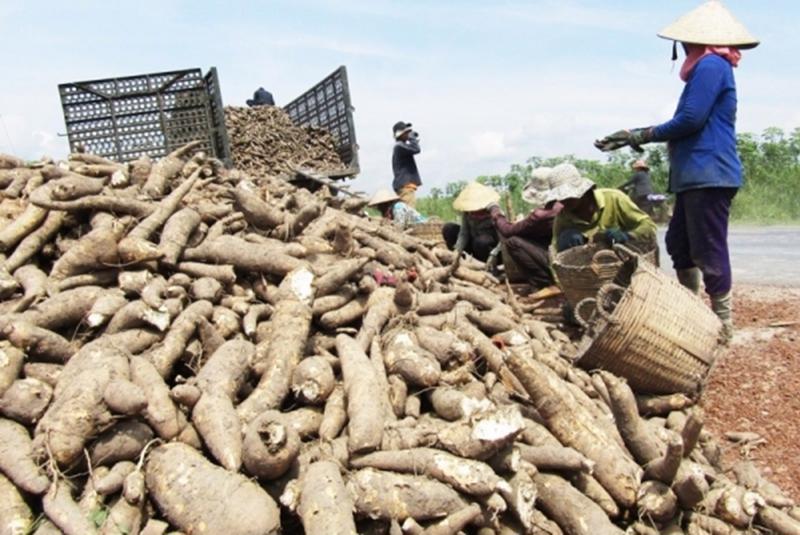Approval of the Scheme "Sustainable development of the cassava industry until 2030, vision to 2050" in Vietnam
What are the details of the Scheme "Sustainable development of the cassava industry until 2030, vision to 2050" approved by the Ministry of Agriculture and Rural Development? - Quang Tung (Hai Phong)

Approval of the Scheme "Sustainable development of the cassava industry until 2030, vision to 2050" in Vietnam (Internet image)
Regarding this matter, LawNet would like to answer as follows:
On April 17, 2024, the Ministry of Agriculture and Rural Development of Vietnam issued Decision 1115/QD-BNN-TT approving the Scheme "Sustainable development of the cassava industry until 2030, vision to 2050".
Approval of the Scheme "Sustainable development of the cassava industry until 2030, vision to 2050" in Vietnam
The Ministry of Agriculture and Rural Development approves the Scheme "Sustainable Development of the Cassava Industry by 2030, Vision by 2050" with the following perspectives, objectives, and development orientations:
(1) Perspectives
- Consistent with the Strategy for Sustainable Agriculture and Rural Development for the period 2021–2030, with a vision towards 2050; and the Strategy for Crop Development by 2030, with a vision towards 2050.
- In line with the natural, economic, and social conditions of each locality, with a focus on land conditions, crop structure orientation, meeting market demand, and improving production efficiency.
- Promoting the application of science and technology in cassava production and processing, prioritizing seed selection and cultivation techniques, promoting deep processing and product diversification to meet market requirements, and maximizing the use of by-products in cassava production and processing.
- Developing production along the value chain, closely link production and consumption of cassava based on enterprises as the center, cooperatives and cooperative groups as the bridge between enterprises and cassava-growing households.
- Encouraging and mobilizing resources from economic components to invest in cassava production, processing, and export. The state will create mechanisms, policies, and invest in accordance with the law.
(2) Objectives
(2.1) General objectives
Develop the cassava industry in a stable, efficient, and sustainable manner; establish close linkages between production, processing, and product consumption to create high economic value, contribute to employment, reduce poverty, and improve the livelihoods of rural residents; increase the export value; and protect the environment.
(2.2) Specific objectives
* By 2030:
- The national fresh cassava output reaches approximately 11.5–12.5 million tons, of which the fresh cassava used for deep processing into various products (starch, ethanol, MSG, etc.) accounts for about 85%.
- The area of cassava cultivation using quality-standardized seeds reaches 40–50%.
- The area of cassava cultivation applying sustainable cultivation practices reaches 50%.
- The export value of cassava and cassava products reaches 1.8–2.0 billion USD.
* Vision by 2050:
Vietnam's cassava industry continues to develop sustainably, with 70–80% of cassava cultivation areas applying sustainable cultivation practices, and the fresh cassava used for deep processing into various products (starch, ethanol, MSG, etc.) accounting for over 90%. The export value of cassava and cassava products reaches approximately 2.3–2.5 billion USD.
(3) Development orientations
(3.1) Cassava production development orientation
By 2030, the national cassava cultivation area will be approximately 480–510 thousand hectares, with a fresh tuber output of 11.5–12.5 million tons, distributed as follows in 5 key regions:
- North Central Mountains: The cultivated area reaches 100–105 thousand hectares, with a fresh tuber output of 1.8–2.0 million tons, focusing on provinces such as Son La, Dien Bien, Yen Bai, Hoa Binh, Lai Chau, etc.
- North Central Coast: The cultivated area reaches 50–55 thousand hectares, with a fresh tuber output of 1.1–1.2 million tons, focusing on provinces such as Nghe An, Thanh Hoa, Quang Tri, Quang Binh, etc.
- South Central Coast: The cultivated area reaches 85–90 thousand hectares, with a fresh tuber output of 2.1–2.3 million tons, focusing on provinces such as Phu Yen, Binh Thuan, Quang Ngai, Binh Dinh, etc.
- Central Highlands: The cultivated area reaches 150–160 thousand hectares, with a fresh tuber output of 3.5–3.7 million tons, focusing on provinces such as Gia Lai, Dak Lak, Kon Tum, etc.
- Southeast: The cultivated area reaches 90–95 thousand hectares, with a fresh tuber output of 3.1–3.3 million tons, focusing on provinces such as Tay Ninh, Dong Nai, Ba Ria-Vung Tau, Binh Phuoc, etc.
(3.2) Orientation for Cassava Processing Development
By 2030, continue to encourage economic components to invest in the construction or upgrading of cassava processing plants (for starch, ethanol, MSG, etc.). At the same time, promote the development of cassava-based processing enterprises such as cake and candy production, glucose syrup, instant noodle production, and animal feed production. Priority should be given to the use of new and advanced technologies in cassava processing to improve quality, maximize the use of by-products, and protect the environment.
Regarding the field of cassava processing, the processing capacity in each region by 2030 is as follows:
- North Central Mountains: The total processing capacity reaches 0.6–1.0 million tons of fresh tubers per year.
- North Central Coast: The total processing capacity reaches 1.0–1.2 million tons of fresh tubers per year.
- South Central Coast: The total processing capacity reaches 1.0–1.2 million tons of fresh tubers per year.
- Central Highlands: The total processing capacity reaches 2.0–2.2 million tons of fresh tubers per year.
- Southeast: The total processing capacity reaches 8.5–9.2 million tons of fresh tubers per year.
More details can be found in Decision 1115/QD-BNN-TT, which comes into force from April 17, 2024.
- Key word:
- cassava industry
- Vietnam
- 2024's plan for inspection of the registration of security interests in land use rights or property on land in Vietnam
- To promote the implementation of solutions to manage the gold market in the upcoming time in Vietnam
- Criteria for professional standards and qualifications of vocational college-level teachers in Vietnam as of June 25, 2024
- To improve the quality of the Vietnam Farmers' Association's operation in the new period
- Cases of convening the General Meeting of Members in Vietnam as of July 1, 2024
- Criteria for professional standards of vocational intermediate-level teachers in Vietnam as of June 25, 2024
-

- The Ministry of Health's request regarding proactive ...
- 12:05, 02/05/2024
-

- Scope of activities of healthcare workers in agencies ...
- 14:30, 03/01/2024
-

- Specific expenditures on benefits for leaders ...
- 08:36, 16/06/2023
-

- Lawyers who leave during Vietnam's National Congress ...
- 15:46, 07/10/2022
-

- Regulations on Vietnam's Fund for Prevention and ...
- 10:09, 07/10/2022
-

- Vietnam’s amendments to annual updates on knowledge ...
- 17:21, 18/05/2024
-

- Contents of planning and land use plans for areas ...
- 17:17, 18/05/2024
-

- Vietnam’s regulation on specialized classrooms ...
- 17:12, 18/05/2024
-

- Vietnam's Law on Fire Safety and Rescue to be ...
- 17:08, 18/05/2024
-

- Vietnam’s list of drugs manufactured by at least ...
- 17:02, 18/05/2024

 Article table of contents
Article table of contents
